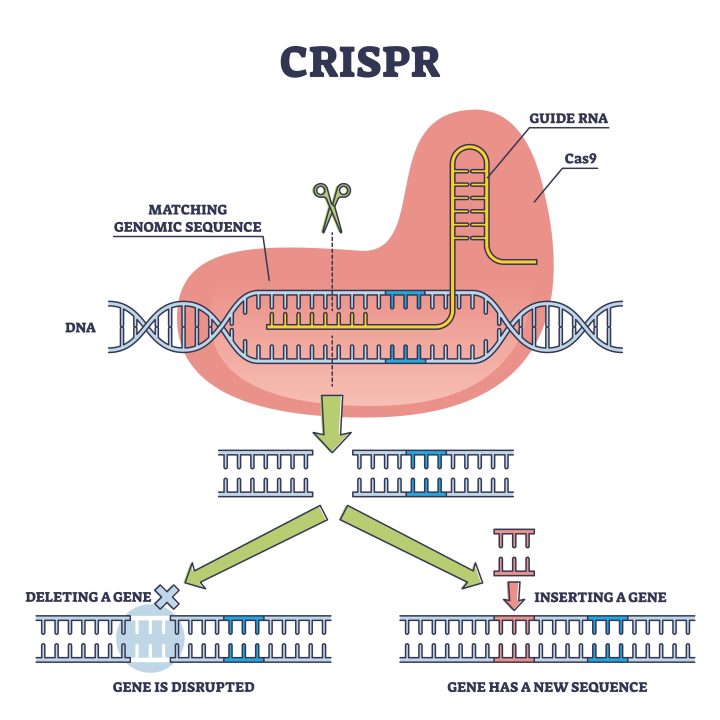CRISPR – a gene editing tool
DNA is the instruction handbook for life on Earth. It encodes an organism's essential traits, such as how it lives, grows, and reproduces. Altering any piece of DNA is called gene editing. CRISPR-Cas9 is a gene editing technique that is causing quite a stir in the scientific community. Scientists are ecstatic about this approach since it is faster, less expensive, and more precise than previous gene editing procedures.
This one-of-a-kind method enables researchers to edit DNA by deleting, adding, or changing DNA sequences. This is a great tool for treating diseases, improving agriculture, and studying basic biological questions.
What is CRISPR?
"CRISPR" (pronounced "crisper") stands for Clustered Regularly Interspaced Short Palindromic Repeats. These are naturally found in archaea (a group of single-celled organisms) and bacteria (which are very tiny organisms that can be seen only through a microscope). CRISPR is a straightforward method of locating a specific piece of DNA within a cell. The following stage in CRISPR gene editing is generally to modify that portion of DNA. CRISPR, on the other hand, has also been designed to do other things, such as turning genes on or off without affecting their sequence. The CRISPR technique relies on CRISPR-associated enzymes (also known as CAS enzymes). The CRISPR-Cas 9 system is comprised of two major components:
- The Cas-9 enzyme functions as a pair of "molecular scissors" that can cut the two strands of DNA at a specified spot in the genome, allowing for the addition or removal of bits of DNA.
- A gRNA (guide ribose nucleic acid) is a fragment of RNA. The RNA protein is related to DNA. The guide RNA is intended to locate and attach to a specific sequence in the DNA. The gRNA contains RNA bases (A, U, G, and C) that are complementary to the target DNA bases (A, T, G, and C) in the genome.
How does it work?

Consider this: you have a toy train track that represents your DNA, and the genetic code you wish to edit is the piece exactly here (use the picture above as a reference). As a result, scientists create a short code sequence known as guide RNA (gRNA) that matches the component you wish to alter. The guide RNA is then attached to a protein called Cas9 (the brown kidney shape in the above image). The gRNA and Cas9 work together to search the cell's nucleus (where DNA is stored) for a matching piece of DNA. They then lock on and begin working.
Cas9 opens the DNA and inserts the gRNA to ensure a match. If this is the case, Cas9 functions as a pair of scissors, splitting the DNA into two parts. Scientists can utilize this to delete a problematic section of a genetic code, such as removing the gene responsible for gluten in wheat to make wheat a gluten-free grain. Then, using the cell's natural DNA repair mechanism, they can twist the cell to sew in a new gene where the old one was. This is known as gene editing, and it is the reason CRISPR is so popular. And scientists aren't the only ones using it.
Agricultural companies are developing crops that are resistant to climate change, highly nutritious vegetables, and even apples that do not turn brown. Pharmaceutical companies are utilizing it to create new classes of antibiotics and other life-saving medications. One day soon, doctors might even prescribe CRISPR-based therapies to treat genetic diseases like cystic fibrosis or sickle cell anemia.
Applications of CRISPR editing in plants
Scientists are investigating ways to leverage the tool's gene-editing capabilities to reduce diseases in some crops while making others more resilient. Also, to modify the DNA of diverse crops to make them tastier, more nutritious, or more resistant to heat and stress.
- Tropic Biosciences, located in the United Kingdom, has created a naturally decaffeinated gene-edited variety of coffee beans. Using CRISPR, the firm was able to switch off the genes that drive the beans to produce caffeine. This variety has the potential to improve decaf coffee's taste, nutrition, and affordability. Currently, creating decaf coffee necessitates an expensive and time-consuming procedure in which the beans are soaked and steamed.
- Scientists in Brazil and Ireland are using CRISPR to create the world's first naturally spicy tomato. Many of the genes essential to create capsaicin, the chemical that gives chili peppers their spiciness, appear to be present in tomatoes. The researchers could potentially give tomatoes the missing genes to make them spicy using CRISPR alterations.
- In the Netherlands, another research group is utilizing CRISPR-Cas9 to change the DNA of wheat in order to delete the gluten gene, making it appropriate for celiac. (Celiac illness is caused by consuming gluten-containing foods.)
- At Hudson River Biotechnology in the Netherlands, scientists are employing CRISPR-based gene editing for specific trait development for improving speed and efficiency in plant breeding.
- At Cold Spring Harbor Laboratory in New York, CRISPR is being used to make tomato plants with branches that are designed to sustain the weight of ripe tomatoes without breaking.
Conclusion
- CRISPR technology has evolved as a powerful and adaptable tool for gene editing, influencing many aspects of biotechnology, including molecular biology, genetics, agricultural and industrial biotechnology, and even food technology.
- Despite the fact that CRISPR technology has a lot of potential, more research is needed to make it safe and accessible.
- We hope that in the near future, CRISPR technology will live up to its promise by being utilized carefully and cautiously.
For more interesting articles in the sphere of plant science and molecular biology, keep checking this space.
By Priyanka Biala | 25th October 2022
References
- https://www.labiotech.eu/best-biotech/crispr-applications-gene-editing/
- https://www.vox.com/2018/7/23/17594864/crispr-cas9-gene-editing
- https://www.yourgenome.org/facts/what-is-crispr-cas9
- https://explorebiotech.com/crispr-gene-editing-tool/
- https://www.livescience.com/59602-crispr-advances-gene-editing-field.html
- https://innovativegenomics.org/education/digital-resources/what-is-crispr/
